
Topics
Guests
- Elena Sokovaexecutive director of the Vienna Center for Disarmament and Non-Proliferation.
We are on the road in the historic city of Vienna, Austria, not far from the Czech Republic where President Obama gave a major address in 2009 that called for a nuclear-free world. His disarmament efforts were cited when he won the Nobel Peace Prize, but since then advocates say little progress has been made. A recent New York Times investigation found the United States is on pace to spend as much as $1 trillion over the next three decades to modernize its nuclear arsenal and facilities. This week, more than 150 countries at the United Nations signed a joint statement calling on nuclear powers to attend the third major conference on the humanitarian impact of nuclear weapons scheduled this December in Vienna. The United States has yet to attend one of the meetings. We are joined by Elena Sokova, executive director of the Vienna Center for Disarmament and Non-Proliferation.
Transcript
AMY GOODMAN: We’re on the road broadcasting from the studios of Okto Community Television here in the historic city of Vienna, capital of Austria, in the heart of Europe. It was five years ago that President Obama was in the neighboring country, the Czech Republic, for a major address in Prague where he called for a world free from nuclear weapons.
PRESIDENT BARACK OBAMA: So today, I state clearly and with conviction America’s commitment to seek the peace and security of a world without nuclear weapons. First, the United States will take concrete steps towards a world without nuclear weapons. To put an end to Cold War thinking, we will reduce the role of nuclear weapons in our national security strategy and urge others to do the same. Make no mistake: As long as these weapons exist, the United States will maintain a safe, secure and effective arsenal to deter any adversary and guarantee that defense to our allies, including the Czech Republic. But we will begin the work of reducing our arsenal. To reduce our warheads and stockpiles, we will negotiate a new strategic arms reduction treaty with the Russians this year. To achieve a global ban on nuclear testing, my administration will immediately and aggressively pursue U.S. ratification of the Comprehensive Test Ban Treaty. After more than five decades of talks, it is time for the testing of nuclear weapons to finally be banned.
AMY GOODMAN: Well, that was April 2009. Later that year, President Obama’s disarmament efforts were cited when he won the Nobel Peace Prize. Since then, the United States has failed to meet its nuclear promises. In fact, a recent New York Times investigation found the United States is on pace to spend as much as $1 trillion over the next three decades to rebuild its nuclear arsenal and facilities. As of 2013, the Federation of American Scientists estimates Russia has about—a stockpile of about 8,000 nuclear warheads, while the U.S. has about 7,300.
Meanwhile, this week, more than 150 countries at the United Nations signed a Joint Statement on the Humanitarian Consequences of Nuclear Weapons—nearly 80 percent of the body’s member states. It cited the “catastrophic effects” of a nuclear weapon detonation, whether by accident or design, and said, quote, “The only way to guarantee that nuclear weapons will never be used again is through their total elimination.” The statement also called on nuclear powers to attend the third Conference on the Humanitarian Impact of Nuclear Weapons scheduled this December here in Vienna, Austria. The United States has yet to attend one of the meetings.
Well, for more, we’re joined here in Vienna by Elena Sokova, executive director of the Vienna Center for Disarmament and Non-Proliferation.
Elena, we welcome you to Democracy Now!
ELENA SOKOVA: Thank you for inviting me.
AMY GOODMAN: There is not a tremendous amount of attention on nuclear weapons. You know, there’s a great deal of attention, for example, on the threat of ISIS in Syria and Iraq. But behind the scenes—I mean, this exposé in The New York Times was quite stunning, the difference between what President Obama was saying just next door here, in the Czech Republic, in 2009 about a nuclear-free world and what is actually happening.
ELENA SOKOVA: You’re right that the promises and the announcements made in 2009 in Prague really elevated hopes of people around the world that we’re seriously approaching and dealing with the nuclear weapons and their reductions. But the recent requests from Pentagon and Congress, that President Obama yet to decide upon, project the U.S. arsenal upgrades and modernizations into 40, 50 years from now. Is that the wrong message to send? If you’re going down the goal of Global Zero, elimination of weapons, you’re not spending one trillion of dollars into upgrading your nuclear arsenal. No one says that nuclear weapons should be completely abandoned and not kept safe and secure. But nevertheless, there are a number of these weapons that are completely obsolete: Military doesn’t like them; they have no real purpose. Some of them are, for example, nuclear bombs, gravity bombs, that used on—by heavy bombers as delivery systems. They haven’t been really factored into many of the even military scenarios.
AMY GOODMAN: Explain what “Global Zero” is.
ELENA SOKOVA: Global Zero is a goal of getting down to zero nuclear weapons. Of course, even president in his speech said that is a long road, and it’s a tedious road, and expected many bumps in this road. But if we are not working towards that goal, if we are not pushing, we are not agreeing on concrete steps to, first, reducing nuclear weapons significantly and then eliminating them, then how do we reach that Global Zero goal? And speaking here from Europe, some of these modernizations and upgrades really don’t make sense. Some of the—the only weapons that U.S. has outside of its border are in Europe. These are the same B-61 gravity bombs that are located in five countries in Europe, literally next door—Italy, Germany, Belgium, the Netherlands and Turkey. It’s 180 bombs that have no, really, mission here in Europe or in the U.S.
AMY GOODMAN: In 2012, three peace activists infiltrated a U.S. nuclear facility that holds more than 400 tons of highly enriched uranium, enough to fuel more than 10,000 nuclear warheads. It was a house painter, a Vietnam vet and an 82-year-old nun who broke into the Y-12 nuclear facility in Oak Ridge, Tennessee, and cut holes in the fence to paint peace slogans. And they also threw blood on the wall. This is Sister Megan Rice speaking about the action in an interview with The Tennessean.
SISTER MEGAN RICE: The appropriate thing was to bring the truth, express the truth, in a way that we could do as quickly as we could and as clearly and as starkly. So we used symbols. Then we also brought the sacred element or symbol of human blood, because so much blood has been shed or would be shed by any of the weapons that would be either refurbished or refined or continue to be built, and hopefully never to be used, but as a stark reminder.
AMY GOODMAN: Sister Megan Rice received a nearly three-year sentence for her actions, and the other two activists involved were sentenced to five years in prison. Their actions prompted the facility to shut down for two weeks and led to congressional hearings about vulnerability of nuclear material. Recent reports show the price tag for renovations to buildings that process uranium at the Oak Ridge facility in Tennessee has soared from $6.5 billion to $19 billion. Elena Sokova, what about these kind of actions and what they show?
ELENA SOKOVA: These actions and the fact that three activists could break into the so-called Fort Knox of the U.S., which houses highly enriched uranium, the material that goes into the nuclear weapons, demonstrates that there are risks and vulnerabilities. And the only way to eliminate these risks is to go down the road and eliminating the weapons and materials for them. And that is a bigger goal. And even if the U.S. has problems with securing some of these top-secret facilities housing them, what about the rest of the world?
AMY GOODMAN: I also want to turn Eric Schlosser, the author of Command and Control: Nuclear Weapons, the Damascus Accident, and the Illusion of Safety. During an interview on Democracy Now!, he described one of several nuclear “near misses” on American soil.
ERIC SCHLOSSER: One of the most significant near misses occurred just three days after John F. Kennedy was inaugurated. A B-52 bomber broke apart in the sky over North Carolina, and as it was breaking apart, the centrifugal forces affecting the plane pulled a lanyard in the cockpit, which released one of the hydrogen bombs that it was carrying. And the weapon behaved as though it had been released over the Soviet Union, over an enemy target deliberately. And it went through all of its arming stages, except one. And there was one switch that prevented it from detonating in North Carolina. And that switch later was found to be defective and would never be put into a plane today. Stray electricity in the bomber as it was disintegrating could have detonated the bomb.
AMY GOODMAN: Eric Schlosser also noted that in 2010, 50 U.S. nuclear missiles suddenly went offline and were unable to communicate with launch control centers for about an hour due to a computer malfunction. Elena Sokova, if you could comment?
ELENA SOKOVA: What Eric Schlosser described in his book are not the only cases when we almost had near uses or near misses, where nuclear weapons were almost launched because something else was mistaken for the incoming nuclear missiles. There is a recent study published by the Chatham House in London that describes additional cases. And what it demonstrates, that there are vulnerabilities, there are risks, and risk is more than zero, and how we can afford not dealing with this problem of nuclear weapons and the reduction and elimination, if this risk indeed exists. And it’s larger than we thought. All these cases that are now become public demonstrates that we didn’t know about it, and we were really fortunate not to have these incidents happen. Sometimes it’s just a human decision that said that “I cannot believe the data on the radar. I better not do a false alarm.” But how we, as a humankind, we can rely always on these decisions?
That’s why the conferences that will be held in Vienna here in December, on December 8 and 9, on the humanitarian impact of nuclear weapons, it will look not only at what are the impacts, short- and long-term, of the weapons on health, on environment, on the food security, on the climate change. But most importantly, it will also look at what the risks are, how vulnerable we are, and how we can deal with that risk, and what if indeed a miscalculation happened or an accident happened, or even premeditated. We speak about nuclear terrorism and other problems. There is no adequate response that we can have. The International Red Cross conducted studies a couple of years ago where they say even a limited, a one nuclear weapon detonation would put severe stress on the whole response system, on medical personnel, on how do you even go and help the individuals who have been under radiation and burns suffering there, because you cannot even move in. Your infrastructure is shattered by the explosion, as well.
AMY GOODMAN: Finally, in the editorial in The New York Times that accompanied this big exposé on how President Obama, despite his promises in 2009 next door in Czech Republic, has now spent—invested tens of billions of dollars in rebuilding America’s nuclear arsenal, yet, they say, “after good progress in making nuclear bomb material more secure around the world, [Mr.] Obama has reduced his budget requests for that priority.” The significance of this, both increasing the money that’s going into developing nuclear weapons, but then cutting back on securing the nuclear weapons around the world that we have?
ELENA SOKOVA: Well, I think the message is clear, that we really need to follow the priorities that we announced, and that the priorities identified in the Prague agenda were to deal with the elimination of nuclear weapons and risks. Securing nuclear materials is very important, and the funding need to be continued. There are more places in the world that we need still to clean up these materials, and we want to make sure that even the weapons that are remained are kept secure.
AMY GOODMAN: Is the U.S. attending the December conference?
ELENA SOKOVA: That, we don’t know yet. We really hope that they will, that the U.S. will attend—hopefully, other countries will do, as well—because U.S. probably one of the countries that know more than anyone else about the effects. It used their nuclear weapons, the only country that ever used their nuclear weapons. It has an, you know, abundance of data from the nuclear testing and could really contribute to the discussion. What the conference and this humanitarian approach is trying to do is to look at the issue of nuclear weapons not from the security, strategic security viewpoint that has been on the agenda for a long time; it looks at the issue from the humankind perspective of what are we dealing with, can we cope with this, what are the risks, and why don’t we turn table around and look at as an entire humankind, not only the countries that have nuclear weapons.
AMY GOODMAN: Well, Elena Sokova, I want to thank you so much for being with us, executive director of the Vienna Center for Disarmament and Non-Proliferation right here in Vienna, Austria.
This is Democracy Now!, democracynow.org, The War and Peace Report. As negotiations around Iran and their nuclear facilities go on here in Vienna, one former U.N. weapons inspector, Robert Kelley, is raising questions about what Western officials are saying about Iran. Stay with us.

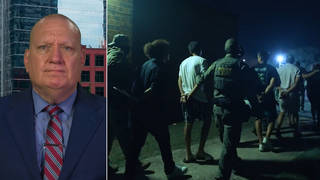
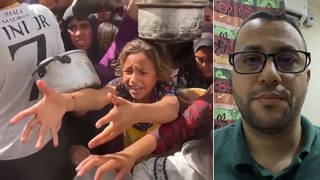
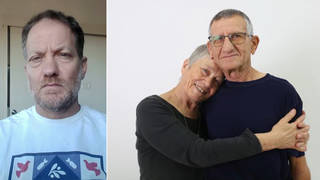
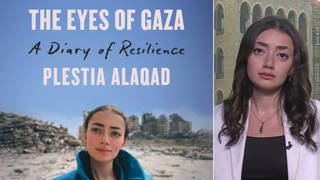



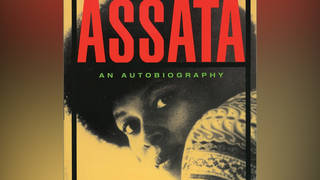

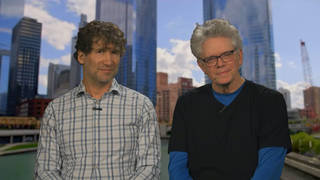
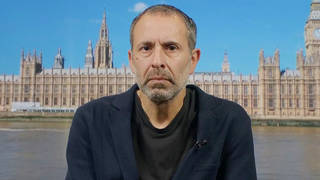
Media Options